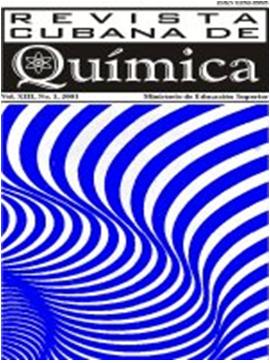First report of anthraquinonesin leaves from picramniagracilistul
Abstract
Picramnia species have been known for their ethnobotanical use in traditional medicine and as promising sources of natural dyes. Picramniagracilis (URU) is a species used as bytheIka indigenous community of the Sierra Nevada de Santa Marta, Colombia as a source of natural colorants, distributed in the Neotropic of the American continent. Ethanolic extract of leaves of the species was fractionated with solvents of increasing polarity and purified by column chromatography for isolation and identification of the anthraquinones previously registered in genus: aloe-emodin, emodin, chrysophanol and nataloe-emodin, and are reportedfor the first time in the species. The compounds were identifiedby HPLC-DAD and NMR 1H and 13Cspectroscopy.The analysis of the extract obtained from the fibers dyed with this species, showed that the anthraquinoneschrysophanol (1) and nataloe-emodin (2) as the main coloring compounds present, responsible for their dyed property.
Keywords: picramniagracilis, anthraquinones,nataloe-emodin, natural dyes, dyed property.
References
CASTROVIEJO, S., IBÁÑEZ A., Consejo Superior de Investigaciones Científicas (España). Estudios sobre la biodiversidad de la región de Bahía Honda (Veraguas, Panamá). Editorial CSIC - CSIC, 2005. ISBN 978-84-00-08405-9.
HERNANDEZ, M., et al., "An anthrone from Picramnia antidesma",Phytochemistry. 1998, 49(8), 2599–2601. ISSN 0031-942
HERNANDEZ, M., et al., "Diastereomeric C-glycosyloxanthrones from Picramnia antidesma",Phytochemistry. 1999, 50(8), 1379–1383. ISSN 0031-9422.
SOLÍS, P., et al., "Bioactive anthraquinone glycosides from Picramnia antidesma ssp. Fessonia". Phytochemistry. 1995, 38(2), 477–480. ISSN 0031-9422.
ALONSO-CASTRO, et al., "Mexican medicinal plants used for cancer treatment: Pharmacological, phytochemical and ethnobotanical studies",Journal of Ethnopharmacology. 2011, 133(3), 945–972. ISSN 0378-8741.
HERNANDEZ, M., MÉNDEZ, L., REYES, N., "Nuevo diglicósidoantraquinónico de Picramniaxalapensis",RevistaCubana de Química. 2007, 19(1), 68–70. ISSN 0258-5995.
BALDERRAMA, L., et al., "Triterpenes and anthraquinones from Picramnia sellowii Planchon in Hook (Simaroubaceae)",Biochemical Systematics and Ecology. 2001, 29(3), 331–333. ISSN 0305-1978.
HERNÁNDEZ, M., et al., "Mayoside, an oxanthrone from Picramniahirsuta". Phytochemistry. 1996, 43(1), 279–281. ISSN 0031-9422.
HERNÁNDEZ, M., et al.,"Characterization and biological activity of fatty acids from Picramnia polyantha fruits",Revista Latinoamericana de Química. 2009, 37(3), 262–269. ISSN 0370-5943.
DIAZ, F., et al., "Anthrone and Oxanthrone C-Glycosides from Picramnia latifolia Collected in Peru". Journal of Natural Products. 2004, 67(3), 352–356. ISSN 0163-3864.
HERNÁNDEZ-MEDEL, M., PEREDA-MIRANDA, P., "Cytotoxic Anthraquinone Derivatives from Picramniaantidesma". PlantaMedica. 2002, 68(6), 556–558. ISSN 0032-0943, 1439-0221.
JACOBO-HERRERA, N., et al., "Medicinal plants used in Mexican traditional medicine for the treatment of colorectal cancer". Journal of Ethnopharmacology. 2016, 179, 391–402. ISSN 0378-8741.
APONTE, J. C., et al., "Isolation of Cytotoxic Metabolites from Targeted Peruvian Amazonian Medicinal Plants". Journal of Natural Products. 2008, 71(1), 102–105. ISSN 0163-3864.
HERNÁNDEZ-MEDEL, M., SOLÍS-FUENTES, J.,MÉNDEZ-VENTURA, L., "Antraquinonas de Picramnia polyantha",Revista Cubana de Química. 2016, 28(3), 805–817. ISSN 2224-5421.
TRUJILLO, W., GONZALEZ, V., "Plantas medicinales utilizadas por tres comunidades indígenas en el noroccidente de la Amazonía (Colombia)",Mundo Amazónico. 2011, 2(0), 283–306. ISSN 2145-5082.
RODRÍGUEZ, T., et al., "Two anthrones and one oxanthrone from Picramnia teapensis",Phytochemistry. 1999, 51(4), 583–586. ISSN 0031-9422.
RODRÍGUEZ, T., et al., "Anthrone and oxanthrone C,O-diglycosides from Picramnia teapensis",Phytochemistry. 2000, 55(7), 837–841. ISSN 0031-9422.
RODRÍGUEZ-GAMBOA, T., et al., "Triterpene benzoates from the bark of Picramniateapensis (Simaroubaceae)". Journal of the Brazilian Chemical Society. 2001, 12(3), 386–390. ISSN 0103-5053.
ROBLEDO, S., et al., "Antileishmanial Effect of 5,3′-Hydroxy-7,4′-dimethoxyflavanone of Picramnia gracilis Tul. (Picramniaceae) Fruit: In Vitro and In Vivo Studies".Advances in Pharmacological Sciences. 2015, 2015, 1–8. ISSN 1687-6334, 1687-6342.
DEVIA, B., et al., "Aproximación al conocimiento de los colorantes en la comunidad indígena Ika de la Sierra Nevada de Santa Marta (departamento del Cesar, Colombia)". Nuevo Mundo Mundos Nuevos.2016. ISSN 1626-0252.
SANTOS, R., SILVA, M., BRAZ-FILHO, R.,"Constituintes químicos do caule de Senna reticulata Willd. (Leguminoseae): Chemical constituents isolated from the wood of SennareticulataWilld". Química Nova. 2008, 31(8), 1979–1981. ISSN 0100-4042.
CONNER, J. M., et al."Anthraquinone, anthrone and phenylpyrone components of Aloe nyeriensis var. kedongensis leaf exudate". Phytochemistry. 1987, 26(11), 2995–2997. ISSN 0031-9422.
GIJN, R., HIRTZEL, V., GIPPER, S., "Updating and loss of color terminology in Yurakaré: An interdisciplinary point of view". Language & Communication. 2010, 30(4), 240–264. ISSN 0271-5309.
VALADEAU, C., et al., "The rainbow hurts my skin: Medicinal concepts and plants uses among the Yanesha (Amuesha), an Amazonian Peruvian ethnic group".Journal of Ethnopharmacology. 2010, 127(1), 175–192. ISSN 0378-8741.
RIVEROS, L., INGA, L., "Caracterización química de los extractos colorantes de siete especies forestales y del fijador natural, utilizado en 19 comunidades indígenas de Ucayali, Perú".Ciencia Amazónica (Iquitos). 2014, 4(1), 29–36. ISSN 2222-7431.
Downloads
Published
How to Cite
Issue
Section
License
This journal provides immediate open access to its content, based on the principle that offering the public free access to research helps a greater global exchange of knowledge. Each author is responsible for the content of each of their articles.























